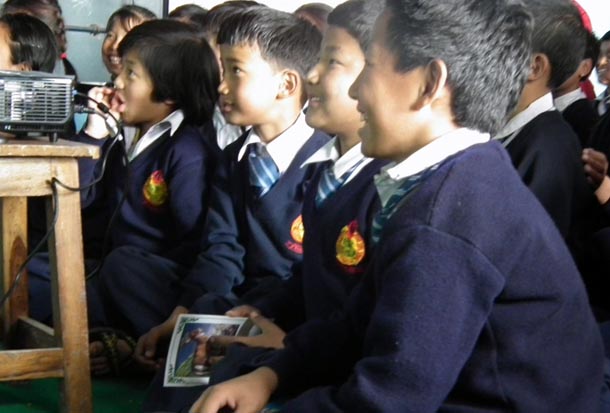 Dharamshala: Tibetan youth are learning about the fragile ecology of their homeland thanks to researchers from Tibet's Environment and Development Desk (EDD). Researchers Ms. Chokyi and Mr. Jigme Norbu spoke today with students at the Central School for Tibetans (CST) in Kalimpong about the most pressing concerns facing the Tibetan Plateau.
Dharamshala: Tibetan youth are learning about the fragile ecology of their homeland thanks to researchers from Tibet's Environment and Development Desk (EDD). Researchers Ms. Chokyi and Mr. Jigme Norbu spoke today with students at the Central School for Tibetans (CST) in Kalimpong about the most pressing concerns facing the Tibetan Plateau.
The talk was part of an ongoing campaign to raise awareness among Tibetan youth about the issues facing the unique and diverse ecology of "The Third Pole". The series began last year with talks held at the Tibetan Children's Village School in Ladakh.
Their tour of northern India began at the CST Darjeeling and CST Sonada on Tuesday. They also visited the Sambhota Tibetan School in Pokhriabong. A statement from EDD said that the "Talks concluded with good responses from both the students and teachers."
This year's program includes the screening of a documentary called "Meltdown in Tibet". The film's website reiterates many of the issues discussed by the researchers. It is also a reminder of the interconnectedness of our world and that the Plateau's destruction spawns from activities of all corners of the globe.
The greatest threat is the disappearing glaciers which are the origin of many of Asia's major rivers. These glaciers are melting faster than anywhere in the world. Without concerted efforts, disappearing glaciers could have devastating effects for some 1.8 billion people who depend, directly and indirectly, upon this water source. The heating of the world's atmosphere has accelerated drastically in recent years, largely a result of human activities. The world's largest contributors of green house gases in absolute numbers are China, the U.S. and India, but the per capita emissions are far greater in developed nations than in developing ones.
Another point of discussion was the damming of the rivers. Five of the World Wildlife Fund's ten most threatened rivers originate on the Tibetan Plateau and much of the danger comes from the voracious appetite for hydropower of the surrounding countries. China is the world's largest builder of dams. The world's largest dam is the Three Gorges Dam along the Yangzi River. A mere three years after opening, the dam has flooded neighbouring areas, displaced 1.3 million people, and daily collects some three tonnes of refuse. It is described by environmental experts as an "Ecological time-bomb".
Resource extraction is another pertinent discussion topic on the tour. Among many issues associated with mining on the Plateau is that it releases arsenic, a poisoning metalloid, into the groundwater. Using arsenic-laden water is already a health problem around Asia.
Recent mineral discoveries in the mountainous and previously isolated terrain of the Plateau have caused investors to froth. China welcomes foreign capital and expertise to extract minerals. Canadian companies are leading the way. Montreal-based Bombardier led the construction of the railway that connects the resource-rich mountains to export zones. Canada-based mining companies that are involved in the area include: Lara Exploration, Sterling Group, Inter-Citic Minerals Inc., Eldorado Gold and China Gold International Resources Corp. Ltd. On top of the inherent environmental consequences of these activities, they perpetuate the domination of the Tibetan people by the Chinese.
The struggle facing the region's ecology is an imminent threat. Director of Ecological Buddhism, Dr. John Stanley, stated in 2008 that without immediate action, "Asian civilization will not survive" and that the current agenda of the countries whose livelihoods are so dependent upon the Tibetan Plateau has "no bearing on the survival of billions of people, or civilization as we know it."
Changing the management of humanity's most important survival mechanism is vital. The EDD is doing a good job spreading this message to youth. They will continue their efforts tomorrow at Sambhota Tibetan School in Gangtok and on May 2 at CST in Ravangla.


![Tibet has a rich history as a sovereign nation until the 1950s when it was invaded by China. [Photo: File]](/images/stories/Pics-2024/March/Tibet-Nation-1940s.jpg#joomlaImage://local-images/stories/Pics-2024/March/Tibet-Nation-1940s.jpg?width=1489&height=878)















